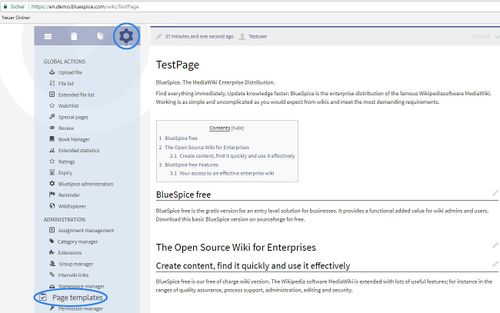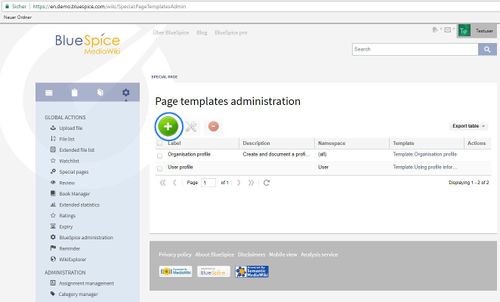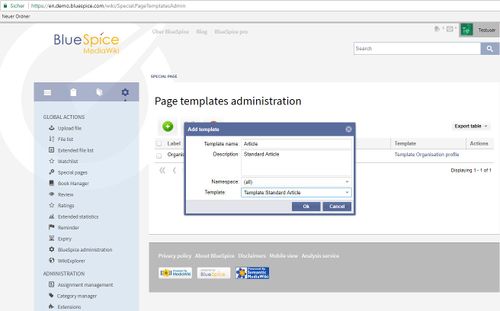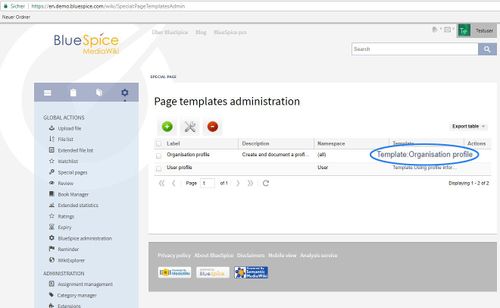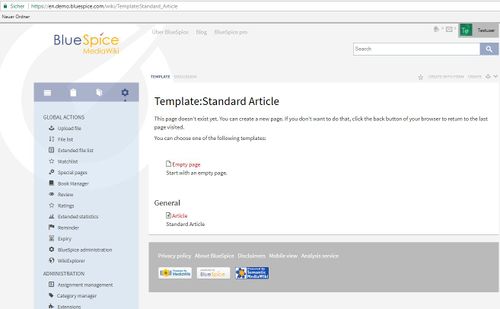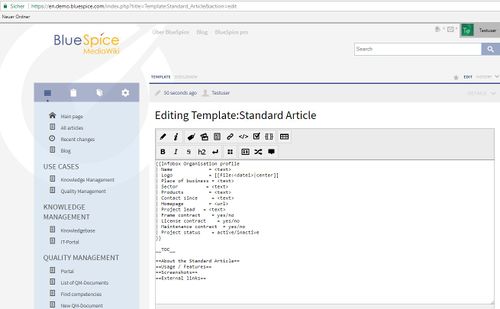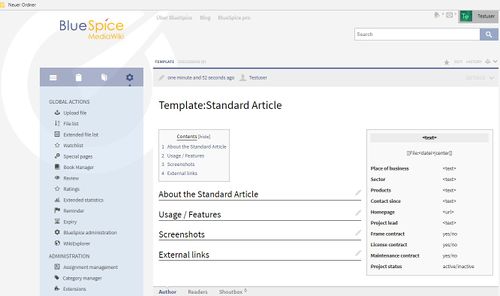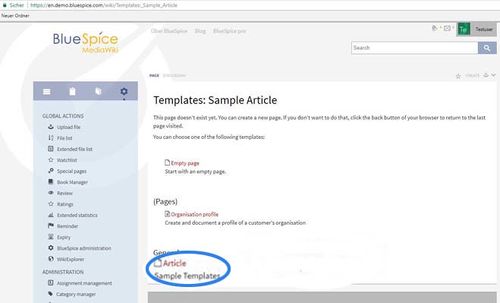Difference between revisions of "Reference:BlueSpicePageTemplates"
(Tag: 2017 source edit) |
Extension: BlueSpicePageTemplates
| Overview | |||
|---|---|---|---|
| Description: | Offers the possibility to select from predefined content structures when creating a new page Displays a list of templates marked as page templates | ||
| State: | stable | Dependency: | BlueSpice |
| Developer: | HalloWelt | License: |
GPL-3.0-onlyProperty "BSExtensionInfoLicense" (as page type) with input value "</br>GPL-3.0-only" contains invalid characters or is incomplete and therefore can cause unexpected results during a query or annotation process. |
| Type: | BlueSpice | Category: | Content Structuring |
| Edition: | BlueSpice free, BlueSpice pro, BlueSpice Farm, BlueSpice Cloud | ||
Features
Contents
PageTemplates offer the possibility to select from predefined content structures (templates, eg content directory, blocks, layout, content elements) when creating a new page, thus creating uniformity for certain page types..
How can I create page templates as an administrator?[edit | edit source]If you have admin rights in the wiki, you can choose the page "Page Templates" in the user sidebar in the left hand navigation menu under "Admin". You will then be forwarded to the administration page. This allows you to define existing pages as templates in your wiki.
Go to the management page PageTemplates via the Admin tab. You can see all the templates which already exist. You can edit or delete these.
The button lets you add new templates.
In the new window, you need to enter the following information:
- Name: Enter a name for your template.
- Description: A short description of your template.
- Namespace: In which namespaces the new template is to be used.
- Namespace of the template: The namespace of the page which you want to be used as the template.
- Template: The page you want to use at the template (filtered by the namespace of the template).
After clicking "Ok" you will get:
Create template article, insert content you want to appear on the pages using this template. If, for example, an infobox is integrated, you will need to enter the wikicode view to enter the data.
Save the article to see how your page template with all the content in it looks like.
How to use page templates?[edit | edit source]If you are an author in the wiki creating a new article you will see the template view. You can choose a fitting template from those which already exist.
The selection of page templates you have available as a user depends on various factors.
- The page template "empty page" is always available
- Page templates for particular namespaces are only available when creating a new page in that namespace
- Page templates for all namespaces are available for all new pages
Templates can contain a list of contents, blocks, a particular layout or specific elements of content.
After choosing the template your new page will be preloaded with the contents of Template:Standard Article page.
Tips for working with page templates[edit | edit source]
- Page templates are particularly good for designing structures for minutes and logs, but they are also excellent for typical business or product data for marketing, sales and product management.
- If you use the BlueSpice package [bookmaker] to create online manuals, page templates can safe a lot of time for you. Create a page template for articles in a manual including the fitting "Bookshelf-tag". So you don't have to copy the chapter navigation into every single article.
Classical page templates with MediaWiki[edit | edit source]
Page templates can also be manually embedded in wikis without page template manager. The prerequisite is that the wiki has the extension PageTemplates.
Try it![edit | edit source]BlueSpicePageTemplates allows users to create new pages from predefined templates to start with a basic page structure.
- Create a template (with headers, categories, boxes and other content) in the template namespace.
- Create a page template using the special page Special_PageTemplatesAdmin give the page template a name and a description.
- Each template should be assigned a template from the "Template" namespace that represents the structure of a document.
- Page templates can be assigned to a particular namespace, so that a certain template will only appear when creating pages in that namespace.
- The page template is shown as a choice when a new page is created.
Some aspects of this extension can be configured on the page Special:BlueSpiceConfigManager, under "Page templates". Here, wiki administrators can:
- Force a target namespace for the page that was created from the template
- Hide default templates
Technical Information[edit source]
This information applies to BlueSpice 3 . Technical details for BlueSpice cloud can differ in some cases.
Requirements[edit source]
- MediaWiki: 1.31
- BlueSpiceFoundation: 3.2
Integrates into[edit source]
Special pages[edit source]
- PageTemplatesAdmin
Permissions[edit source]
| Name | Description | Role |
|---|---|---|
| pagetemplatesadmin-viewspecialpage | Access to the Special:PageTemplatesAdmin special page, where page templates can be managed | admin, maintenanceadmin, structuremanager |
Configuration[edit source]
| Name | Value |
|---|---|
| PageTemplatesExcludeNs | array ( 0 => -2, 1 => -1, 2 => 6, 3 => 7, 4 => 8, 5 => 9, 6 => 10, 7 => 11, 8 => 14, 9 => 15, ) |
| PageTemplatesForceNamespace | false |
| PageTemplatesHideDefaults | false |
| PageTemplatesHideIfNotInTargetNs | true |
API Modules[edit source]
- bs-pagetemplates-store
- bs-pagetemplates-tasks
Hooks[edit source]
{{BSExtensionInfoboxBSExtensionInfo
|desc=Offers the possibility to select from predefined content structures when creating a new page.
|status=stable
|developer=HalloWelt
|type=BlueSpice
|edition=BlueSpice free, BlueSpice pro
|active=Yes
, BlueSpice Farm, BlueSpice Cloud
|compatible=BlueSpice
|category=Content Structuring
|docu=https://www.mediawiki.org/wiki/Extension:PageTemplates
}}
__TOC__
'''PageTemplates''' offer the possibility to select from predefined content structures (templates, eg content directory, blocks, layout, content elements) when creating a new page, thus creating uniformity for certain page types..
===How can I create page templates as an administrator?===
If you have admin rights in the wiki, you can choose the page "Page Templates" in the user sidebar in the left hand navigation menu under "Admin". You will then be forwarded to the administration page. This allows you to define existing pages as templates in your wiki.
::: [[File:PgeTmlts1.jpg|500x313px]]
Go to the management page '''PageTemplates''' via the '''Admin''' tab. You can see all the templates which already exist. You can edit or delete these. <br />The button [[File:Seitenvorlage_neu_anlegen.PNG]] lets you add new templates.
::: [[File:PgeTmlts2.jpg|500x302px]]
::: [[File:PTemplates3.jpg|500x311px]]
In the new window, you need to enter the following information:
* '''Name''': Enter a name for your template.
* '''Description''': A short description of your template.
* '''Namespace''': In which namespaces the new template is to be used.
* '''Namespace of the template''': The namespace of the page which you want to be used as the template.
* '''Template''': The page you want to use at the template (filtered by the namespace of the template).
After clicking "Ok" you will get:
::: [[File:PgeTmlts3.jpg|500x308px]]
::: [[File:PTemplates6a.jpg|500x309px]]
Create template article, insert content you want to appear on the pages using this template. If, for example, an infobox is integrated, you will need to enter the wikicode view to enter the data.
::: [[File:PTemplates7.jpg|500x309px]]
Save the article to see how your page template with all the content in it looks like.
::: [[File:PTemplates8.jpg|500x296px]]
==How to use page templates?==
If you are an author in the wiki creating a new article you will see the template view. You can choose a fitting template from those which already exist.
::: [[File:PgeTmlts4.jpg|500x303px]]
The selection of page templates you have available as a user depends on various factors.
* The page template "empty page" is always available
* Page templates for particular namespaces are only available when creating a new page in that namespace
* Page templates for all namespaces are available for all new pages
Templates can contain a list of contents, blocks, a particular layout or specific elements of content.
After choosing the template your new page will be preloaded with the contents of Template:Standard Article page.
==Tips for working with page templates==
* Page templates are particularly good for designing structures for minutes and logs, but they are also excellent for typical business or product data for marketing, sales and product management.
* If you use the BlueSpice package <nowiki>[bookmaker]</nowiki> to create online manuals, page templates can safe a lot of time for you. Create a page template for articles in a manual including the fitting "Bookshelf-tag". So you don't have to copy the chapter navigation into every single article.
==Classical page templates with MediaWiki==
Page templates can also be manually embedded in wikis '''without page template manager'''. The prerequisite is that the wiki has the extension ''PageTemplates''.
==Try it!==
[https://en.demo.bluespice.com/wiki/Main_Page BlueSpice Demo]
{{Box_Links-en | Thema1 =[[Create_new_articles|Create new article]] | Thema2 =[[NamespaceCss|Change style of single namespaces]] | Thema3 =[[Bookmaker|Structure of a book in the Wiki]] | Thema4 = }}
::: [[de:{{FULLPAGENAME}}]][[en:{{FULLPAGENAME}}]]
[[Category:Extension]]license=GPL v3 only
|features=
'''BlueSpicePageTemplates''' allows users to create new pages from predefined templates to start with a basic page structure.
*Create a template (with headers, categories, boxes and other content) in the template namespace.
*Create a page template using the special page Special_PageTemplatesAdmin give the page template a name and a description.
*Each template should be assigned a template from the "Template" namespace that represents the structure of a document.
*Page templates can be assigned to a particular namespace, so that a certain template will only appear when creating pages in that namespace.
*The page template is shown as a choice when a new page is created.
Some aspects of this extension can be configured on the page Special:BlueSpiceConfigManager, under "Page templates". Here, wiki administrators can:
*Force a target namespace for the page that was created from the template
*Hide default templates
}}| (41 intermediate revisions by 5 users not shown) | |||
| Line 1: | Line 1: | ||
| − | {{ | + | {{BSExtensionInfo |
| − | |desc=Offers the possibility to select from predefined content structures when creating a new page | + | |desc=Offers the possibility to select from predefined content structures when creating a new page. |
|status=stable | |status=stable | ||
|developer=HalloWelt | |developer=HalloWelt | ||
|type=BlueSpice | |type=BlueSpice | ||
| − | |edition=BlueSpice free, BlueSpice pro | + | |edition=BlueSpice free, BlueSpice pro, BlueSpice Farm, BlueSpice Cloud |
| − | |||
|compatible=BlueSpice | |compatible=BlueSpice | ||
|category=Content Structuring | |category=Content Structuring | ||
| − | | | + | |license=GPL v3 only |
| − | + | |features= | |
| − | + | '''BlueSpicePageTemplates''' allows users to create new pages from predefined templates to start with a basic page structure. | |
| − | + | *Create a template (with headers, categories, boxes and other content) in the template namespace. | |
| + | *Create a page template using the special page Special_PageTemplatesAdmin give the page template a name and a description. | ||
| + | *Each template should be assigned a template from the "Template" namespace that represents the structure of a document. | ||
| + | *Page templates can be assigned to a particular namespace, so that a certain template will only appear when creating pages in that namespace. | ||
| + | *The page template is shown as a choice when a new page is created. | ||
| − | + | Some aspects of this extension can be configured on the page Special:BlueSpiceConfigManager, under "Page templates". Here, wiki administrators can: | |
| − | |||
| − | + | *Force a target namespace for the page that was created from the template | |
| − | + | *Hide default templates | |
| − | |||
| − | |||
| − | |||
| − | + | }} | |
| − | |||
| − | |||
| − | |||
| − | |||
| − | |||
| − | |||
| − | |||
| − | |||
| − | |||
| − | |||
| − | |||
| − | |||
| − | |||
| − | |||
| − | |||
| − | |||
| − | |||
| − | |||
| − | |||
| − | |||
| − | |||
| − | |||
| − | |||
| − | |||
| − | |||
| − | |||
| − | |||
| − | |||
| − | |||
| − | |||
| − | |||
| − | |||
| − | |||
| − | |||
| − | |||
| − | |||
| − | |||
| − | |||
| − | |||
| − | |||
| − | |||
| − | |||
| − | |||
| − | |||
